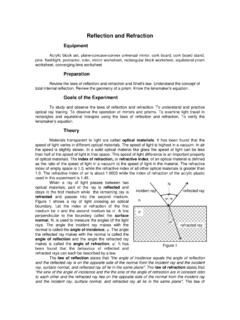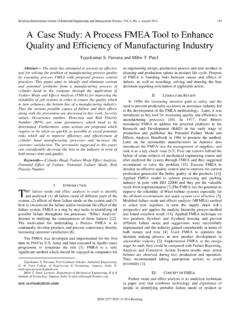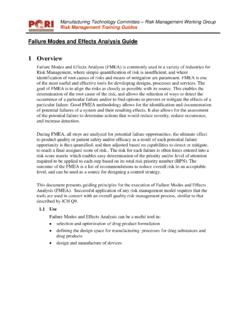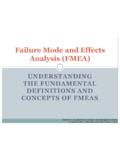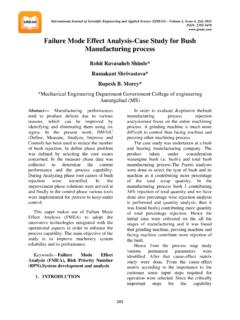Transcription of Failure Modes & Effects Analysis - University of Calgary
1 Failure Modes & Effects Analysis 1 of 10V Failure Modes and Effects Analysis (FMEA), also known as Failure Modes , Effects ,and Criticality Analysis (FMECA), is a systematic method by which potential failures of aproduct or process design are identified, analysed and documented. Once identified, theeffects of these failures on performance and safety are recognised, and appropriateactions are taken to eliminate or minimise the Effects of these failures. An FMEA is acrucial reliability tool that helps avoid costs incurred from product Failure and activities in which the FMEA is useful: Throughout the entire design process but is especially important during theconcept development phase to minimise cost of design changes Testing Each design revision or updateOther tools that are useful in conjunction with the FMEA: Brainstorming Fault Tree Analysis (FTA) Risk ManagementIntroductionThe FMEA process is an on-going, bottom-up approach typically utilised in three areas ofproduct realization and use, namely design, manufacturing and service.
2 A design FMEA examines potential product failures and the Effects of these failures to the end user, whilea manufacturing or process FMEA examines the variables that can affect the quality of aprocess. The aim of a service FMEA is to prevent the misuse or misrepresentation of thetools and materials used in servicing a is not a single, correct method for conducting an FMEA, however the automotiveindustry and the Department of Defense (Mil-Std-1629A) have standardisedprocedures/processes within their respective realms. Companies who have adopted theFMEA process will typically adapt and apply the process to meet their specific , the main elements of the FMEA are: The Failure mode that describes the way in which a design fails to perform asintended or according to specification; The effect or the impact on the customer resulting from the Failure mode; and the cause(s) or means by which an element of the design resulted in a Modes & Effects Analysis 2 of 10V is important to note that the relationship between and within Failure Modes , Effects andcauses can be complex.
3 For example, a single cause may have multiple Effects or acombination of causes could result in a single effect . To add further complexity, causescan result from other causes, and Effects can propagate other Should Complete the FMEAAs with most aspects of design, the best approach to completing an FMEA is with cross-functional input. The participants should be drawn from all branches of the organisationincluding purchasing, marketing, human factors, safety, reliability, manufacturing andany other appropriate disciplines. To complete the FMEA most efficiently, the designershould conduct the FMEA concurrently with the design process then meet with the cross-functional group to discuss and obtain consensus on the Failure Modes identified and theratings between Reliability and SafetyDesigners often focus on the safety element of a product, erroneously assuming that thisdirectly translates into a reliable product.
4 If a high safety factor is used in product design,the result may be an overdesigned, unreliable product that may not necessarily be able tofunction as intended. Consider the aerospace industry that requires safe and reliableproducts that, by the nature of their function, cannot be of the Design FMEAAs mentioned previously, there is not one single FMEA method. The following ten stepsprovide a basic approach that can be followed in order to conduct a basic FMEA. Anexample of a table lamp is used to help illustrate the process. Attachment A provides asample format for completing an 1: Identify components and associated functionsThe first step of an FMEA is to identify all of the components to be evaluated. This mayinclude all of the parts that constitute the product or, if the focus is only part of a product,the parts that make up the applicable sub-assemblies.
5 The function(s) of each part withinin the product are briefly :Part DescriptionPart FunctionLight bulbProvides x y lux of illuminationPlug2 wire electrical plugCordConducts power from outlet to lampFailure Modes & Effects Analysis 3 of 10V 2: Identify Failure modesThe potential Failure mode(s) for each part are identified. Failure Modes can include butare not limited to: complete failures intermittent failures partial failures failures over time incorrect operation premature operation Failure to cease functioning at allottedtime Failure to function at allottedtimeIt is important to consider that a part may have more than one mode of :Part DescriptionFailure ModeCordShort circuitOpen curcuitInsulation failureStep 3: Identify Effects of the Failure modesFor each Failure mode identified, the consequences or Effects on product, property andpeople are listed.
6 These Effects are best described as seen though the eyes of : Failure ModeFailure EffectsShortNo light/ Electrical fire/ BlownfuseInsulation failShock/injury hazardStep 4: Determine severity of the Failure modeThe severity or criticality rating indicates how significant of an impact the effect is on thecustomer. Severity can range from insignificant to risk of fatality. Depending on theFMEA method employed, severity is usually given either a numeric rating or a codedrating. The advantage of a numeric rating is the ability to be able to calculate the RiskPriority Number (RPN) (see Step 9). Severity ratings can be customised as long as theyare well defined, documented and applied consistently. Attachment B provides examplesof severity Modes & Effects Analysis 4 of 10V : Failure EffectsSeverityNo light8-Very highShock/injury hazard10-Hazardous-no warningStep 5: Identify cause(s) of the Failure modeFor each mode of Failure , causes are identified.
7 These causes can be designdeficiencies that result in performance failures, or induce manufacturing : Failure ModeCauseInsulation failureCord pinchedStep 6: Determine probability of occurrenceThis step involves determining or estimating the probability that a given cause or failuremode will occur. The probability of occurrence can be determined from field data orhistory of previous products. If this information is not available, a subjective rating ismade based on the experience and knowledge of the cross-functional of the methods used for rating the probability of occurrence are a numeric rankingand a relative probability of Failure . Attachment C provides an example of a numericranking. As with a numeric severity rating, a numeric probability of occurrence ratingcan be used in calculating the RPN. If a relative scale is used, each Failure mode isjudged against the other Failure Modes .
8 High, moderate, low and unlikely are ratings thatcan be used. As with severity ratings, probability of occurrence ratings can becustomised if they are well defined, documented and used :CauseProb. Of OccurrenceCord pinched2-Low (few failures)Step 7: Identify controlsIdentify the controls that are currently in place that either prevent or detect the cause ofthe Failure mode. Preventative controls either eliminate the cause or reduce the rate ofoccurrence. Controls that detect the cause allow for corrective action while controls thatdetect Failure allow for interception of the product before it reaches subsequent operationsor the Modes & Effects Analysis 5 of 10V :CauseCurrent controlsCord pinchedReview CSA standardsWarranty data from precedingproductsStep 8: Determine effectiveness of current controlsThe control effectiveness rating estimates how well the cause or Failure mode canbe prevented or detected.
9 If more than one control is used for a given cause orfailure mode, an effectiveness rating is given to the group of controls. Controleffectiveness ratings can be customised provided the guidelines as previouslyoutlined for severity and occurrence are followed. Attachment D providesexample :Current controlsControl effectivenessReview CSA standards5-ModerateWarranty data from precedingproductsStep 9: Calculate Risk Priority Number (RPN)The RPN is an optional step that can be used to help prioritise Failure Modes for action. Itis calculated for each Failure mode by multiplying the numerical ratings of the severity,probability of occurrence and the probability of detection (effectiveness of detectioncontrols) (RPN=S x O x D). In general, the Failure Modes that have the greatest RPNreceive priority for corrective action. The RPN should not firmly dictate priority assome Failure Modes may warrant immediate action although their RPN may not rankamong the 10: Determine actions to reduce risk of Failure modeTaking action to reduce risk of Failure is the most crucial aspect of an FMEA.
10 TheFMEA should be reviewed to determine where corrective action should be taken, as wellas what action should be taken and when. Some Failure Modes will be identified forimmediate action while others will be scheduled with targeted completion , some Failure Modes may not receive any attention or be scheduled to bereassessed at a later Modes & Effects Analysis 6 of 10V to resolve failures may take the form of design improvements, changes incomponent selection, the inclusion of redundancy in the design, or incorporation designfor safety aspects. Regardless of the recommended action, all should be documented,assigned and followed to , Steven, Failure Analysis Beats Murphy s Laws , Mechanical Engineering,September 1993, pp. , John A., Design Assurance for Engineers and Managers, Marcel Dekker, Inc.




